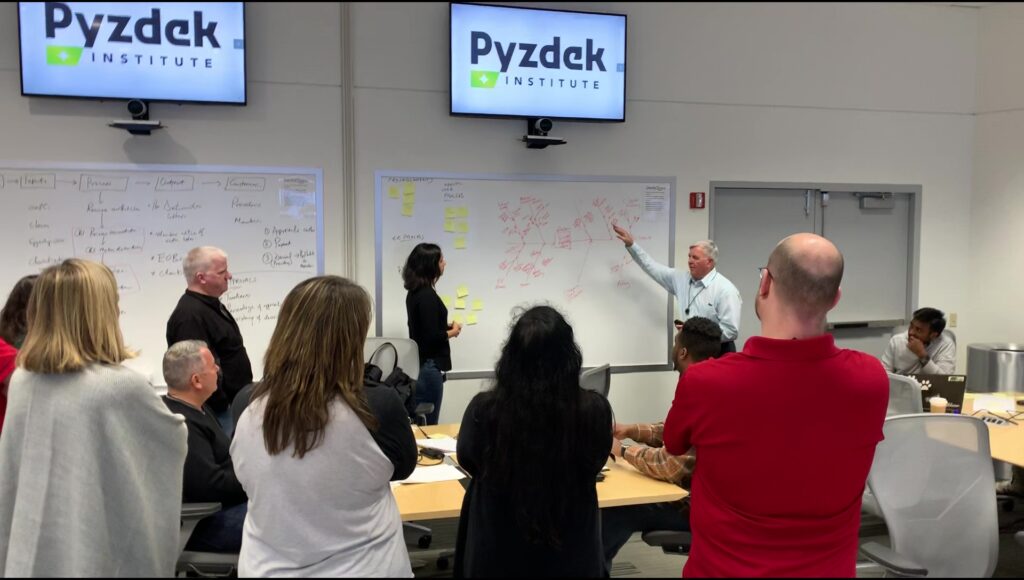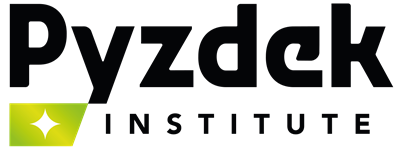Your cart is currently empty!

Lean Six Sigma for Executive Leadership
Develop strategic leadership skills with Lean Six Sigma, empowering executives to drive organizational excellence and continuous improvement.
Course Overview
The Lean Six Sigma for Executive Leadership workshop is based on decades of Pyzdek Institute experience working with manufacturing, service, financial and healthcare customers at every organizational level. The workshop provides practical advice to C-Level Executives, Presidents, Vice-Presidents and Directors on the best way to build and manage an effective process improvement organization and avoid common Operational Excellence and Lean Six Sigma pitfalls and, most importantly, how to lead by example. The workshop also includes practical insight on Lean Six Sigma fundamentals and how they can help increase profits.
About 70% of the workshop material is taught with hands-on exercises, software demonstrations or real-world case studies. The goal of the course is to teach Pyzdek Institute clients to make better, data-centric business decisions and to deliver products and services that are safer, better, faster, cheaper, and more profitable.
- Format: Instructor-led
- Level: Beginner
- Location: On-site
- Duration: 12-24 hours depending on customer need
Course Agenda
The following course agenda is flexible and can be tailored to specific customer interests.
Operational Excellence (OpEx) Leadership
Module one is an overview of Operational Excellence. It includes a summary of the great thought leaders like Deming, Shingo, Ohno, Juran and others followed by discussions of the Operational Excellence mindset. The module includes two hands-on exercises designed to demonstrate important concepts in the building of an OpEx culture.
Specific topics include:
- Deming, Juran, Shingo, Covey, and other thought leaders
- Hands-on exercise: process simulation
- The three important business voices
- Operational Excellence mindset, focus on people and focus on continuous improvement.
- Hands-on exercise: Leading by example.
- Improve the return on your training and statistical software investment.
- Freeform discussion
Lean Six Sigma Leadership
Module two dives deeper into the way Lean Six Sigma fits into a strategic plan for Operational Excellence. The module includes a business case study and hands-on work to demonstrate Lean Six Sigma project selection and related concepts. Also included is a discussion of The One Question that Executives should ask out at the workplace.
Specific topics include:
- Lean Six Sigma strategy & tactics
- Project selection
- Hands-on exercise: L-maps
- Case study
The Lean Mindset
Module three covers fundamental Lean Principles and a proven way to improve process flow and systematically set up process owners for success.
Specific topics include:
- The sequence to Lean Implementation
- 5S and why it often fails.
- Waste and variation kill profits, The Ohno Circle
- Hands-on exercise: Waste Identification (at Gemba, if possible)
- The importance of process mapping
- Hands-on exercise: Spaghetti Diagrams and Value Stream Mapping
- The One Question to ask your production operators.
- Hands-on exercise: Batch processing versus single-piece flow
- The PQPR analysis
- Hands-on exercise: PQPR analysis
- Kaizen is a mindset, not an event.
- Avoiding Kaizen Event pitfalls
- Visual metrics
- Total Productive Maintenance (TPM)
- The Lean Office
- Common Lean pitfalls and how to avoid them.
The Six Sigma (statistical) Mindset
Module four covers fundamental Six Sigma Principles including the best way to analyze data and how to avoid common data analysis pitfalls. Hands-on exercises include Visual Process Risk Assessment, Turn Opinion into Hard Data, Measurement Systems Management and Statistical Process Control along with a demonstration of the way designed experiments can optimize complex production equipment, uncover valuable process knowledge and increase profits.
Specific topics include:
- The Great Numerical Quandary
- The 3 Principles of Statistical Thinking
- Inspection and pass-fail thinking kill profits (Taguchi’s superior view)
- Hands-on exercise: Sequence and delay maps
- Hands-on exercise: Data visualization and common pitfalls
- Your measurement systems may be burning your money.
- Hands-on exercise: Trust no measurement
- Variation kills profits.
- Software demonstration: The power of Shewhart Control Charts
- Technical risk assessment
- Hands-on exercise: The Visual Process Risk Assessment
- If your process is not optimized, you are losing money.
- Software demonstration: Process Optimization
- How to cheaply monitor progress and defeat entropy
- Common Six Sigma pitfalls and how to avoid them.
Live, Instructor-led Training from Certified Master Black Belts

The Pyzdek Institute Lean Six Sigma for Executive Leadership course is delivered live by Certified Master Black Belts, who possess a wealth of experience in applying Lean Six Sigma methodologies and advanced statistical methods across a variety of industries. These seasoned experts not only hold the highest level of Lean Six Sigma certification, but also have a proven track record in leading successful process improvement initiatives.
They bring their practical knowledge to each training session, transforming complex theoretical concepts into actionable strategies. Their interactive approach ensures that participants are actively engaged, fostering a richer learning experience. They are adept at catering to different learning styles and can provide real-time feedback, making the learning process more personalized and effective.
In this course, you will be learning from the best, gaining insights from professionals who have successfully implemented the strategies they teach. With their guidance, you will be equipped to effectively apply statistical methods to reduce costs in your own organization.
Course Structure
| Course content | % of time spent |
|---|---|
| Hands-on exercises and demonstrations | 70% |
| Fundamental principles and discussions | 30% |
Follow-up Consulting
The Pyzdek Institute recommends and offers 4-8 hours of on-site or on-line consulting 6 to 8 weeks after completion of the 3-day course. The purpose of this consultation is to provide guidance on Executive-level Lean Six Sigma work in progress, answer questions and discuss advanced Lean Six Sigma topics.
Take Command of Your Organization’s Continuous Improvement Journey: Lean Six Sigma for Executive Leadership
Drive your organization’s growth and effectiveness through strategic leadership in Lean Six Sigma. This exclusive workshop, designed specifically for C-Level Executives, Presidents, Vice Presidents, and Directors, distills decades of Pyzdek Institute’s experience into actionable insights and practical strategies.
Step into the shoes of industry-leading thought leaders like Deming, Shingo, Ohno, Juran, and Covey, understanding their mindset and principles. Gain hands-on experience with a series of immersive exercises and case studies, ensuring your learning experience is as practical as it is theoretical.
Understand how Lean Six Sigma fits into your strategic plan, how to select the right projects, and how to foster a Lean mindset across your organization. Learn to navigate common pitfalls and maximize your return on investment in training and statistical software.
This workshop is more than just a course – it’s an opportunity to transform your leadership skills, make more informed business decisions, and lead your organization to higher levels of excellence.
Get in touch with us today to secure your place in our Lean Six Sigma for Executive Leadership workshop.
